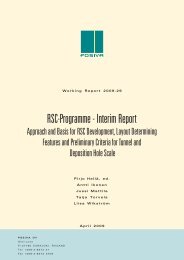Bentonite Mineralogy Part 1: Methods of Investigation - Posiva
Bentonite Mineralogy Part 1: Methods of Investigation - Posiva
Bentonite Mineralogy Part 1: Methods of Investigation - Posiva
Create successful ePaper yourself
Turn your PDF publications into a flip-book with our unique Google optimized e-Paper software.
%T<br />
7.2 Fourier transform infrared spectroscopy {FTIR)<br />
45<br />
The smectite mineral in all studied bentonite samples is montmorillonite (or beidellite ).<br />
The OH-stretching bands in the 3500-3600 cm- region <strong>of</strong> their infrared spectra are<br />
broad and consist <strong>of</strong> several umesolved components. Maximum absorption occurs at<br />
3636 cm- 1 in the Wyoming samples (Fig. 7-9), at 3621-3626 cm- 1 in the Kutch samples,<br />
at 3625-3632 cm- 1 in the Milos samples (Appendix 4) and at 3621 cm- 1 in the Czech<br />
samples (Fig. 7-10). The AIAIOH stretching band typically occurs at 3620-3630 cm- 1 ,<br />
the AIMgOH stretching band at 3687 cm- 1 and the A1Fe 3 +0H band at 3597 cm- 1<br />
(Farmer, 1974). The frequency <strong>of</strong> maximum absorption thus indicates that the smectites<br />
are Al-rich. The broadness <strong>of</strong> the band is due to the contribution <strong>of</strong> Mg and Fe in<br />
octahedral sheets and might also indicate, that the smectite structure is poorly ordered.<br />
In nontronites maximum absorption occurs at frequency ea 3560 cm- 1 (Farmer, 1974).<br />
Nontronite was not identified in any <strong>of</strong> the studied samples.<br />
Wyoming<br />
BH-200<br />
MX-80<br />
4000,0 3000 2000 1500 450,0<br />
cm-1<br />
Figure 7-9. FTIR spectra <strong>of</strong> the Wyoming bentonites, fine fraction.

















